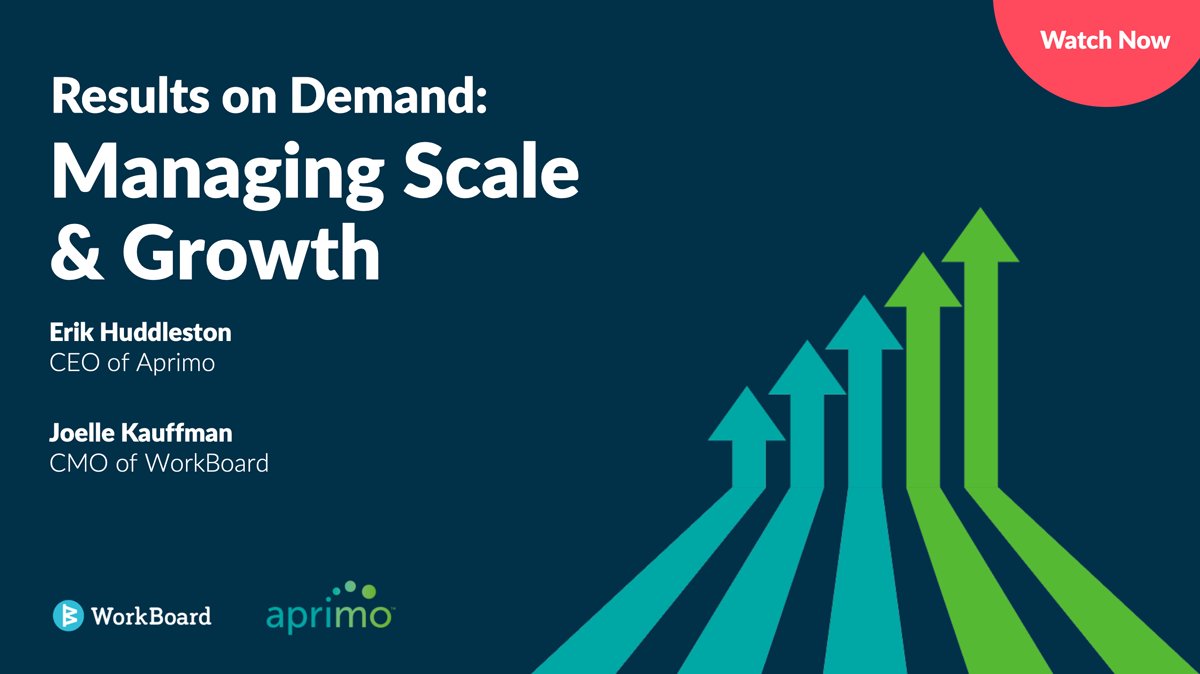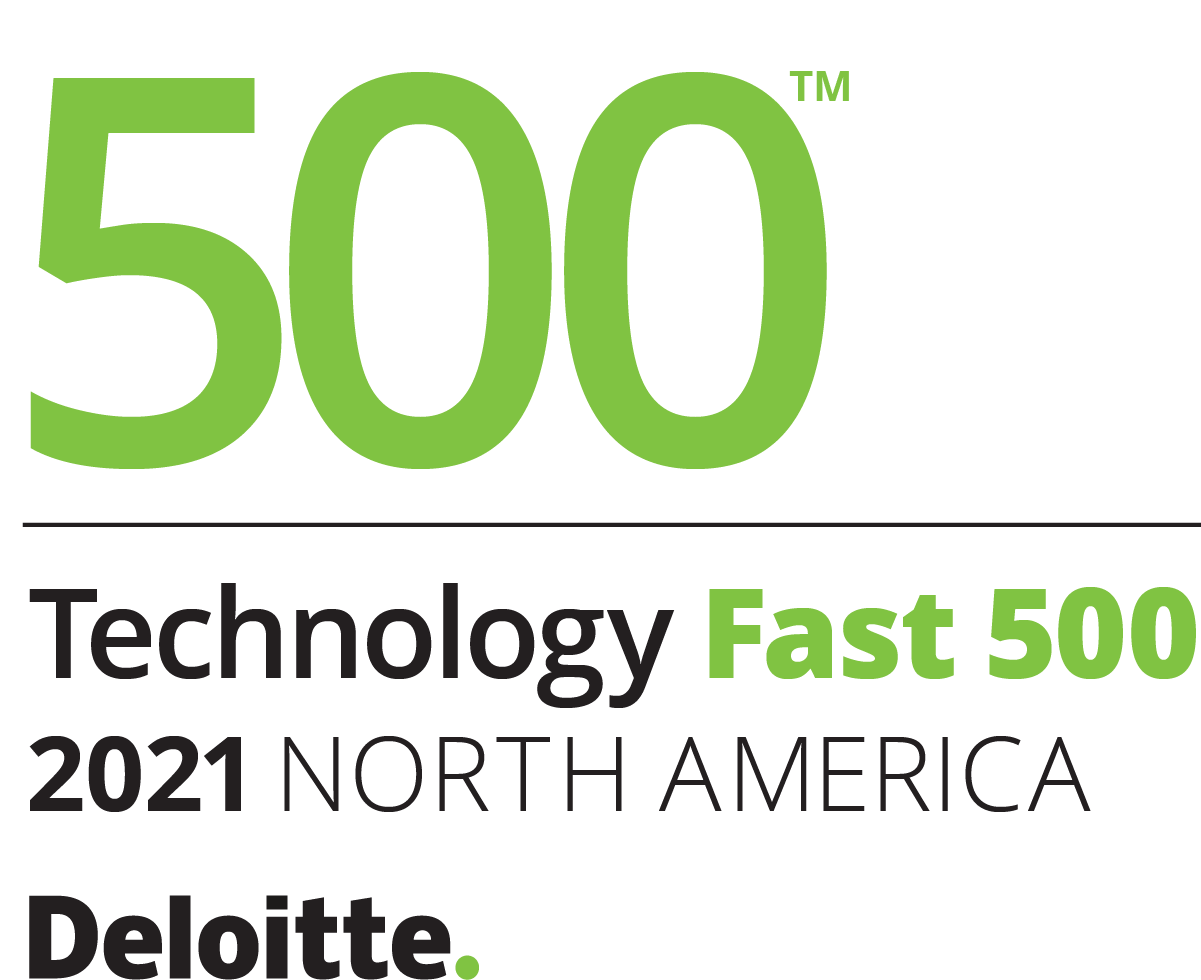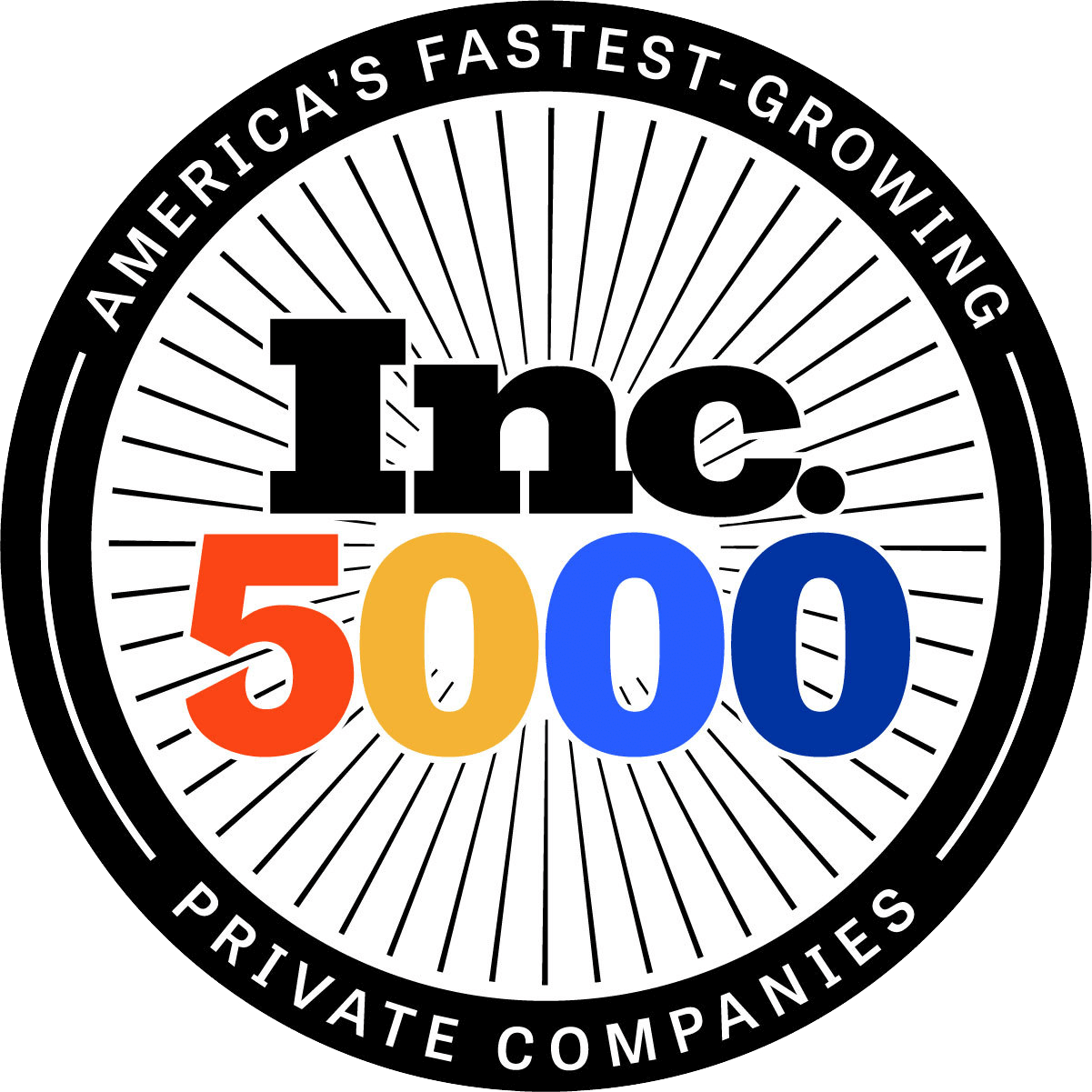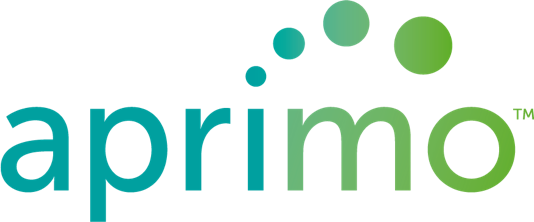We sat down with Erik Huddleston, CEO, Aprimo, to talk about how OKRs and an Outcome Mindset™ keep his teams performing at maximum levels and driving amazing results.
What led you to adopt OKRs?
Erik Huddleston, CEO, Aprimo: I realized I needed a better way of managing scaling growth. My entire career has been largely focused on driving outsized organic growth in an organization. What I’ve discovered is that, while you get a great acceleration of growth in the beginning, it starts to break down over time as it relates to the execution of strategy.
Many years ago, at another company, we’d have a strategic off-site with our management team, where we would do a thorough job of figuring out exactly what we needed to do in the quarter to be successful. Those off-sites grew longer as our organization became more complex, ballooning to a 3-day, 18-hours-per-day off-site that burned the team out.
One week after an off-site, the CMO was in my office. We were rested by then and having a heated conversation in which I asked him if he even knew what our strategic priorities were, which sounds harsh, but during that conversation, we both realized that he — as someone in attendance at the off-site and my thought partner on the executive team — couldn’t articulate them.
If the CMO couldn’t articulate those priorities, how could someone five layers deep in the organization? That was the moment I realized that the single greatest limitation on organizational growth is the organization’s capacity for change — and, by and large, humans don’t like change because it’s uncomfortable. I realized the strategy wasn’t what I needed to be focused on — I needed to focus on increasing the organizational capacity for change. I needed rapid growth and result management, and slow activity management wasn’t going to make it happen.
Most organizations run strategy annually, with a dog and pony show from the CEO and their direct reports. That rear-view mirror approach to results often leads to disappointment about missing them. Alignment needs to happen more often, on a quarterly basis, preferably, so accountability is driven on a weekly or daily cadence — and you can course-correct. Ideally, the process isn’t labor-intensive with a million spreadsheets and a PowerPoint for each one. That’s not the high-performance behavior you need for sustained growth. Prioritizing doing the work over knowing whether the work was done well will not lead to results.
All that led me to focus on the levers I had as a CEO, which were that I could set strategy — and set it on a swift pace — so I could automate my operations and focus on doing things better, ultimately being able to communicate to my team clearly. The challenge of scaling all that to drive results is what led me to adopt OKRs.
The OKR process and platform are the biggest levers you have in creating organizational clarity. That’s why we use WorkBoard.
As a CEO, you really transformed your understanding of your role. You unlocked the innovation ambition and capacity of not only your leadership team but the whole company.
Yes, it was interesting. I’m not sure this is the best metaphor for it, but I bit the bullet and bought a Tesla a while back. As a “car guy,” the most profound difference about a Tesla, to me, was that I never shifted gears — it’s a continuous, smooth acceleration. This performance is unlike when I drove super-fast muscle cars, where I’d feel this huge burst of acceleration in first gear that would pull back as I shifted into second, and so on throughout the gears. Companies shift from stage to stage in a similar way, and I felt that process was stealing my growth potential. I felt like, every time we shifted gears or hit an inflection point, I was coming down from the mountaintop with these edicts that told every single person in the company what to do next. I needed to find a better way, and that realization put me into the mindset of being a guide — where I would set the direction for all of us to go to the mountaintop, and we’d all be empowered to make that journey together. That shift in mindset unlocked an enormous amount of time for me — and, as a CEO, time is the most valuable resource, so how you spend it is the most important decision you make in a day.
So what were you spending your time on before, and what are you spending your time on after you adopted OKRs?
I was spending my time on the details of what everyone needed to do. Now, I spend my time creating organizational clarity and focusing on how I operationalize it. Setting strategy and helping with process improvement is great, but it’s the linkage between the two that lets us understand if the process improvements and KPIs are actually leading to the progress we want as an organization. The management communication and the cadence of that communication is what you implement as a CEO to articulate and execute the strategy of the organization, from operational reviews down to 1:1s, so that the team has the feedback they need to course-correct in the day-to-day execution — especially in faster cycle times or times of change.
OKRs let you zoom out to a more global vision and macro direction — as well as zoom in to the local impact and the opportunities for micro innovations in strategy.
How does this cycle of operationalizing organizational clarity play to your ability to zoom in and zoom out? How are you doing that?
As a reformed command and control leader, I’ll admit that attitude rarely leads to the best outcomes, particularly as you’re growing. Because, as you scale, the complexity of the business increases and there’s a dispersion effect for the details that are required to make decisions effectively at different levels of the organization.
OKRs let you zoom-out to a more global vision and macro direction — as well as zoom in to the local impact and the opportunities for micro innovations in strategy.
For example, if our global objective is to increase pipeline generation, the COO and I are probably not going to come up with the best strategy for fixing lead generation problems in the UK market. That strategy is best coming from the EMEA demand gen manager and the UK sales reps. That zooming in empowers teams to maximize whatever the objective is. I’m a growth guy, and teams are the real engine of growth. OKRs harness teams to have the engine performing at maximum levels while still being focused on global objectives.
One of the challenges that a lot of enterprises and a lot of teams face when they have local responsibility and have to articulate what their best possible results are is that they focus on activities — I’m going to hold this many lead gen events, for example — that are very output-oriented. You’ve changed this mindset at TrendKite, Cision, and now Aprimo. Talk to us a little about how you’ve made it happen.
The output mindset is absolutely the number one problem I see in teams — over and over again. People are working hard, but not necessarily getting the results that the organization is looking for, which causes a lot of friction and frustration with teams. A lot of morale and cultural issues spring from this disconnect, which I call a strategic drift. And that’s because, without a focusing mechanism like OKRS, the complexity gets overwhelming. Without a true North, people tend to focus on the problems that are causing them the most pain at the local level, whatever level they may be.
So, while they may be scratching their own itch, it may not necessarily be aligned to the overall effort. And what that means that your entire organization is working really hard — but sometimes at cross-purposes. That misalignment denies the organizational capacity needed to get work done that drives results.
It is paramount to switch teams to an Outcome Mindset where it’s results that matter, not how much work was put into getting them. I drove this point home at the first Aprimo all-hands. I told everyone that sitting around in your pajamas until noon binging Netflix while also crushing growth goals is a better use of their time than burning out while working 18 hours a day, six days a week.
It is paramount to switch teams to an Outcome Mindset where it’s results that matter, not how much work was put into getting them.
You’re inoculating against the cult of busy. As you’re making this transition with organizations from an output to an Outcome Mindset and encouraging them to localize their contribution to the strategy, you’ve likely encountered some resistance from people in regards to them setting their “best possible.” They’re worried they will be reviewed on what they achieved it or not, or that their bonus or promotion will be based on it, so they don’t want to set a target they’ll fail to reach. How do you overcome that and get people to strive for that best possible?
Transparency is scary, to be intellectually honest. I think about it in the same terms WorkBoard does: if you don’t get over that hurdle, particularly when people’s outputs have been tied to their incentives or compensation, what you typically get is people shooting for the most probable result, or maybe even a hair below that. If that’s what you shoot for, that’s probably what you’re going to get.
If you can rework their mindsets and move them from that fear or discomfort to actually imagining the best possible and then building plans around that, then they’ll be inspired. It doesn’t really matter at the end of the day where they hit, because it’s going to be somewhere between those two lines and wherever it is, all of that was an upside for you as a CEO over what you were going to get before.
What I’ve found is, to make that shift, you have to create psychological safety. Psychological safety is a big reason why you don’t tie OKRs to compensation; it gives people permission to be intellectually honest and accountable for what’s not working exactly right in the organization. If people feel like they’re going to be attacked, they’re not going to speak up when things are going wrong, and they’re going to deflect blame when problems are identified. If you separate the people from the problems so that they’re working as a team to solve them, you get better performance.
A great example of this happened during a particularly problematic period as we were shifting the ideal customer profile and the segments we were targeting. It was clear we were going to come up pretty short in demand gen. But instead of wagging my finger at the CMO and the COO wagging his finger at the vice president of demand generation, we all shared that as a problem. The solutions on the marketing side, in demand gen, were going to take a little bit of time to kick in because producing new content takes a while, and we had to cultivate a different audience, which doesn’t happen overnight.
The sales executive, without even really thinking about it said, “OK, for us to hit our number next quarter, what I can do is I can take my SDRs and my sales reps and increase the amount of outbound cold-calling and emailing to make up for what we’re not going to get from inbound demand generation.” In the end, we didn’t miss our number because the collective team around the table looked at that as a shared problem, not a miss by the CMO.
Psychological safety is a big reason why you don’t tie OKRs to compensation; it gives people permission to be intellectually honest and accountable.
That’s powerful. You made a subtle, but important, distinction about problems — they’re not bad, they’re opportunities we want to surface and seize as early as possible. We call that ”leaning into the red.” Realizing that it’s not a “gotcha” situation is a huge shift for employees. The CEO’s job is organizational clarity and to help teams achieve. The heatmap feature in WorkBoard is great for CEOs and leaders to see where those problems and opportunities are so they can go in and help.
That’s it. Many people talk about the “one team” culture as one of the most powerful things you can cultivate in an organization. You see the manifestation of that ”one team” cultural focus when all of the organization’s talent, creativity, and capacity swarms to the “red.” It’s so powerful when everyone sees swarming to the red as an opportunity to help the whole team.
That’s awesome. How do you sustain this level of organizational excellence?
It’s a cliche, but it’s really a marathon and not a sprint, and it’s vital not to burn people out. Going back to my Tesla metaphor, the real beauty in OKRs is keeping yourself, somewhat uncomfortably, in the yellow flirting with the red line on your RPMs as an organization and staying there for prolonged periods of time, which is one of the advantages of the linkage between strategy and operations that stems from using OKRs.
That cycle perpetuates itself, right?
Absolutely. One of the reasons why OKRs are so powerful is because you have the key results in the context of the objective that you’re trying to accomplish. And, with WorkBoard, you’re able to have that link of key results to context as you get progress updates from your systems.
The executive team has more freedom to take risks, be more creative, and spend less time explaining what they’re doing and more time doing.
You use running business reviews for that, right? You can skip building slides and decks and can even run board meetings off the running business review because it’s all in context, and the progress is all available.
The power of that at the board level is profound. When you have such a firm linkage — as you have with the automation of KRs into WorkBoard — the articulation of strategy and operations execution in that RBR provides transparency. That transparency inspires competence because even if it’s bad news, the board is able to hear it on a frequent basis. And, because you’re not spending 80 hours compiling a spreadsheet or three weeks building a PowerPoint presentation every quarter, the executive team has more freedom to take risks, be more creative, and spend less time explaining what they’re doing and more time doing.
On the flip side, one of the things that I’ve really appreciated about RBRs and OKR transparency to the board is that they provide intellectual honesty on my part and protection from a growth CEO’s stereotypically rose-colored glasses.
A great example of this — I was literally on a board call this morning with a CEO, and the board meeting didn’t go as planned. The CEO had some budgetary requests and wanted to expand their spend, which, given the macro-economics, was a little alarming. We on the board pointed to the KRs associated with the growth and said, “You’re a little soft in some of your core unit economics, so why are you really wanting to invest there?” The CEO came back with this amazing business review where he presented the exact same budget, but now completely reoriented to the organization’s strategic objectives. He peeled out the unit economics to show where the growth was and how those investments they proposed would reinforce it — and got a rubber stamp, no questions asked.
That happens with that feedback loop between operational performance and communication. You’re seeing that with your teams as well — they put their strategies, their proposals into context when they come to the exec team to say, “Here’s what I want to do.”
This is where RBRs and meeting management in WorkBoard come into a tight focus. The communication cadence of the business — staff meetings, operational reviews, and most importantly, one-on-ones — creates this tight linkage between how we’re actually performing and the feedback the team needs to make the micro changes from day-to-day and week-to-week that they need to.
Imagine if you were getting all of your performance feedback in your annual review — you just lost 51 weeks’ worth of continuous improvements. When you’re getting OKR feedback in bite-size increments every week with your manager, and then that’s laddering all the way up to the CEO and then the board, it creates these tight feedback loops that improve performance.
Keeping that same link front and center of the teams and making them talk about all the work they’re doing in the context of your strategic objectives keeps the ship fully aligned, so you don’t get that strategic drift I mentioned earlier, and you keep the organization focused on execution. It tells you when you’re off track — and that’s a critical capability.
OKRs are the glue that binds the strategy I have for growth to the operational processes to the organization’s communication cadence.
What has the impact of doing this been on the results you’ve led your organizations to achieve?
For me, the number one objective is staying on growth curves. OKRs are the glue that binds the strategy I have for growth to the operational processes to the organization’s communication cadence. OKRs have allowed me to realize some amazing outcomes as a result of keeping the velocity of change up in the organization.
The number one takeaway that I want everyone to have is that if you’re a CEO or someone on the broader executive team, you know your number one job is ensuring clarity so that the thousands of people that work for you will make the right decisions — in the moment — every day because every one of those right decisions will become cumulative. “The OKR process and platform are the biggest levers you have in creating organizational clarity. That’s why we use WorkBoard.”









